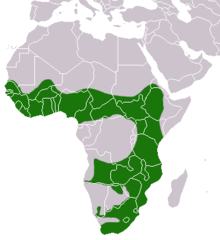This article needs additional citations for verification. (August 2010) |
| African clawless otter | |
|---|---|

| |
| On the banks of the Okavango River, Namibia | |
| Scientific classification | |
| Domain: | Eukaryota |
| Kingdom: | Animalia |
| Phylum: | Chordata |
| Class: | Mammalia |
| Order: | Carnivora |
| Family: | Mustelidae |
| Genus: | Aonyx Lesson, 1827 |
| Species: | A. capensis[1]
|
| Binomial name | |
| Aonyx capensis[1] (Schinz, 1821)
| |

| |
| African clawless otter range | |
| Synonyms[3] | |
| |
The African clawless otter (Aonyx capensis), also known as the Cape clawless otter or groot otter, is the second-largest freshwater otter species. It inhabits permanent water bodies in savannah and lowland forest areas through most of sub-Saharan Africa.[2] It is characterised by partly webbed and clawless feet, from which their name is derived. The word 'aonyx' means clawless, derived from the prefix a- ("without") and onyx ("claw/hoof").
- ^ Wozencraft, W. C. (2005). "Aonyx capensis". In Wilson, D. E.; Reeder, D. M. (eds.). Mammal Species of the World: A Taxonomic and Geographic Reference (3rd ed.). Johns Hopkins University Press. pp. 532–628. ISBN 978-0-8018-8221-0. OCLC 62265494.
- ^ a b c Jacques, H.; Reed-Smith, J. & Somers, M.J. (2021). "Aonyx capensis". IUCN Red List of Threatened Species. 2021: e.T1793A164575819. doi:10.2305/IUCN.UK.2021-3.RLTS.T1793A164575819.en. Retrieved 12 December 2022.
- ^ "Oldstyle id: 577b8ce82b7857d1ada9c14614d1240a". Catalogue of Life. Species 2000: Leiden, the Netherlands.
